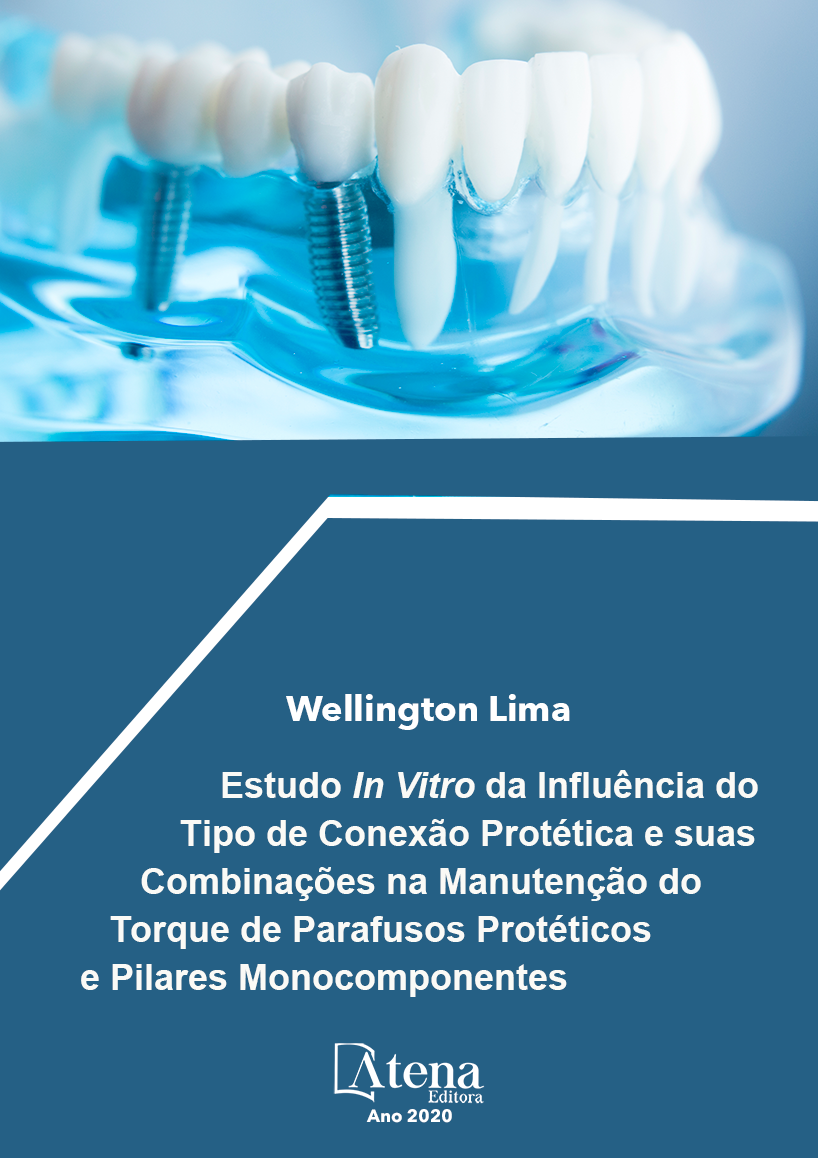
ESTUDO IN VITRO DA INFLUÊNCIA DO TIPO DE CONEXÃO PROTÉTICA E SUAS COMBINAÇÕES NA MANUTENÇÃO DO TORQUE DE PARAFUSOS PROTÉTICOS E PILARES MONOCOMPONENTES
O propósito dessa pesquisa foi analisar a resistência ao torque reverso de parafusos protéticos e pilares protéticos monocomponentes instalados em prótese fixa de três elementos, sobre conexões de hexágono externo, cone morse e combinação dessas conexões, ambos da marca Anthogyr. Foram confeccionadas seis próteses fixas de três elementos, em metalo-cerâmica, ancoradas por dois implantes, divididas em três grupos, com dois conjuntos de próteses em cada grupo: Grupo I: prótese fixa de três elementos, com dois implantes implante hexágono externo, com pôntico unindo pilares; Grupo II: prótese fixa de três elementos, com dois implantes cone morse, com pôntico unindo pilares; Grupo III: prótese fixa de três elementos, com um implante cone morse e um implante hexágono externo, com pôntico unindo pilares. As amostras foram confeccionadas e as peças protéticas foram fixadas por meio de parafusos de titânio, os quais receberam um torque de 10 N.cm. Os pilares protéticos receberam um torque de 20N.cm. As próteses fixas foram submetidas à ciclagem mecânica mastigatória programada a 1.000.000 de ciclos e 2Hz de velocidade com carga de 50N. Ao final das ciclagens as amostras sofriam o torque reverso e os valores encontrados foram submetidos à análise estatística utilizando-se dos testes de Shapiro-Wilk, Levene, t de Student, Tukey e Pearson, conforme a conveniência. Os resultados mostraram que o torque reverso dos parafusos protéticos não foi significativamente afetado independentemente do grupo testado, porém, para os pilares protéticos, quando houve combinação dos dois tipos de conexão, houve uma diferença no torque reverso dos dois pilares, sendo significativamente menor no componente com conexão de hexágono externo. Sendo assim, os resultados mostram que a união de sistemas parece interferir no valor do torque reverso de pilares protéticos.
ESTUDO IN VITRO DA INFLUÊNCIA DO TIPO DE CONEXÃO PROTÉTICA E SUAS COMBINAÇÕES NA MANUTENÇÃO DO TORQUE DE PARAFUSOS PROTÉTICOS E PILARES MONOCOMPONENTES
-
DOI: 10.22533/at.ed.322200605
-
Palavras-chave: Implantação Dentária. Torque reverso. Parafuso protético. Parafuso do pilar. Pilar protético
-
Keywords: Dental Implantation. Reverse torque. Prosthetic screws. Pillar screw. Prosthetic abutment.
-
Abstract:
The purpose of this research was to analyse the resistance to the reverse torque of prosthetic screws and prosthetic abutments installed in fixed prosthesis of three elements, on connections of external hexagon, morse cone and combination of these connections, both brand Anthogyr. Six fixed prostheses of three elements, in metal-ceramic, were manufactured and anchored by two implants, divided into three groups, with two sets of prostheses in each group: Group I: fixed prosthesis of three elements, with two external hexagon implants, with a pontic; Group II: fixed prosthesis of three elements, with two implants morse cone implants, with pontic joining pillars joining pillars; Group III: fixed prosthesis of three elements, with a morse cone implant and an external hexagon implant, with a pontic joining pillars. The sample were made and the prosthetic pieces were fixed by means of titanium screws, which received a torque of 10N.cm. The prosthetic abutments received a torque of 20N.cm. Fixed prostheses were submitted to mechanical masticatory cycling programmed at 1,000,000 cycles and 2HZ velocity at 50N load. At the end of the cycles the samples underwent the reverse torque and the values found were submitted to statistical analysis using the Shapiro-Wilk, Levene, Student t, Tukey and Pearson tests, according to convenience. The results showed that the reverse torque of the prosthetic screws was not significantly affected independently of the group tested, but for the prosthetic abutments, when there was a combination of the two types of connection, there was a difference in the reverse torque of the two abutments, being significantly smaller in the component with external hexagon connection. Thus, the results show that the union of systems seems to interfere in the value of the reverse torque of prosthetic pilar.
-
Número de páginas: 81
- Carlos Alberto Francischone
- Christiana Almeida Salvador Lima
- Wellington Lima


